Alkali-Activated Slag Coatings for Fire Protection of OPC Concrete
Abstract
:1. Introduction
2. Experimental
2.1. Raw Materials
2.2. Test Methods
3. Results and Discussion
3.1. Fire Resistance Tests of Concrete Samples with Alkali-Activated Slag Coatings
3.2. The Residual Compressive Strength of Concrete Samples after Fire Resistance Test
3.3. The Concrete Samples Reinforced with Glass Fiber Polymer Bars after Exposure to Elevated Temperatures
4. Conclusions
Author Contributions
Funding
Informed Consent Statement
Data Availability Statement
Conflicts of Interest
References
- Khoury, G.A. Effect of fire on concrete and concrete structures. Prog. Struct. Eng. Mater. 2000, 2, 429–447. [Google Scholar] [CrossRef]
- Lahoti, M.; Tan, K.H.; Yang, E.H. A critical review of geopolymer properties for structural fire-resistance applications. Constr. Build. Mater. 2019, 221, 514–526. [Google Scholar] [CrossRef]
- Resende, H.F.; Arroyo, F.N.; Reis, E.D.; Chahud, E.; dos Santos, H.F.; Linhares, J.A.T.; Branco, L.A.M.N. Estimation of physical and mechanical properties of high-strength concrete with polypropylene fibers in high-temperature condition. J. Mater. Res. Technol. 2023, 24, 8184–8197. [Google Scholar] [CrossRef]
- Viswanathan, V.; Laha, T.; Balani, K.; Agarwal, A.; Seal, S. Challenges and advances in nanocomposite processing techniques. Mater. Sci. Eng. 2006, 54, 121–285. [Google Scholar] [CrossRef]
- Cheng, T.W.; Chiu, J.P. Fire-resistant geopolymer produced by granulated blast furnace slag. Miner. Eng. 2003, 16, 205–210. [Google Scholar] [CrossRef]
- Carabba, L.; Emrys Scarponi, G.; Tugnoli, A.; Chiara Bignozzi, M.; Moricone, R. Investigation of lightweight geopolymer mortars as fireproofing coatings. In Proceedings of the International Conference on Alkali Activated Materials and Geopolymers: Versatile Materials Offering High Performance and Low Emissions, Hotel Dos Templarios Tomar, Portugal, 27 May–1 June 2018; p. 42. [Google Scholar]
- Payakaniti, P.; Chuewangkam, N.; Yensano, R.; Pinitsoontorn, S.; Chindaprasirt, P. Changes in compressive strength, microstructure and magnetic properties of a high-calcium fly ash geopolymer subjected to high temperatures. Constr. Build. Mater. 2020, 265, 120650. [Google Scholar] [CrossRef]
- Krivenko, P.; Petropavlovsky, O.; Vozniuk, H. Development of mixture design of heat resistant alkali-activated aluminosilicate binder-based adhesives. Constr. Build. Mater. 2017, 149, 248–256. [Google Scholar] [CrossRef]
- Shih, P.H.; Chang, Y.K.; Dai, H.A.; Chiang, L.C. Porous fire-resistant materials made from alkali-activated electric arc furnace ladle slag. Processes 2022, 10, 638. [Google Scholar] [CrossRef]
- Krivenko, P.V.; Guzii, S.G.; Bodnarova, L.; Valek, J.; Hela, R.; Zach, J. Effect of thickness of the intumescent alkali aluminosilicate coating on temperature distribution in reinforced concrete. J. Build. Eng. 2016, 8, 14–19. [Google Scholar] [CrossRef]
- Mohd, A.M.A.B.; Jamaludin, L.; Hussin, K.; Binhussain, M.; Ghazali, C.M.R.; Izzat, A.M. Study on fly ash based geopolymer for coating applications. In Advanced Materials Research. Trans Tech Publ. 2013, 686, 227–233. [Google Scholar]
- Varela, B.; Privorotskaya, N. The use of geopolymers as concrete coatings for fire protection; Geopolymer, green chemistry and sustainable development solution. In Proceedings of the World Congress Geopolymers, Saint-Quentin, France, 28 June–1 July 2005; pp. 209–211. [Google Scholar]
- Papakonstantinou, C.G.; Balaguru, P.N. Geopolymer protective coatings for concrete. In Proceedings of the International sample Symposium and Exhibition, Baltimore, MD, USA, 26–30 November 2007; p. 13. [Google Scholar]
- Temuujin, J.; Rickard, W.; Lee, M.; van Riessen, A. Preparation and thermal properties of fire resistant metakaolin-based geopolymer-type coatings. J. Non-Cryst. Solids 2011, 357, 1399–1404. [Google Scholar] [CrossRef]
- Sakkas, K.; Panias, D.; Nomikos, P.P.; Sofianos, A.I. Potassium based geopolymer for passive fire protection of concrete tunnels linings. Tunn. Undergr. Space Technol. 2014, 43, 148–156. [Google Scholar] [CrossRef]
- Sakkas, K.; Kapelari, S.; Panias, D.; Nomikos, P.; Sofianos, A. Fire Resistant K-Based Metakaolin Geopolymer for Passive Fire Protection of Concrete Tunnel Linings. Open Access Libr. J. 2014, 1, 1. [Google Scholar] [CrossRef]
- Sakkas, K.; Sofianos, A.; Nomikos, P.; Panias, D. Behavior of passive fire protection K-geopolymer under successive severe fire incidents. Materials 2015, 8, 6096–6104. [Google Scholar] [CrossRef]
- Sakkas, K.; Panias, D.; Nomikos, P.; Sofianos, A. Comparison of Fire Resistant Geopolymers for Passive Fire Protection of Concrete Tunnel Linings. Open Access Libr. J. 2017, 4, 1–15. [Google Scholar] [CrossRef]
- Privorotskaya, N. High Temperature Effect of Geopolymeric Coatings on Concretes. Thesis, Rochester Institute of Technology, Rochester, NY, USA, 2005. Available online: https://www.google.com.hk/url?sa=t&rct=j&q=&esrc=s&source=web&cd=&ved=2ahUKEwiK7JHUrOuCAxX8afUHHTDVA6AQFnoECBUQAQ&url=https%3A%2F%2Fscholarworks.rit.edu%2Fcgi%2Fviewcontent.cgi%3Farticle%3D9101%26context%3Dtheses&usg=AOvVaw0g1UFFOcmpWgZK6JKq3Ae8&opi=89978449 (accessed on 1 October 2023).
- Tian, Q.; Wang, S.; Sui, Y.; Lv, Z. Alkali-activated materials as coatings deposited on various substrates: A review. Int. J. Adhes. Adhes. 2021, 110, 102934. [Google Scholar] [CrossRef]
- Jiang, D.; Shi, C.; Zhang, Z. Recent progress in understanding setting and hardening of alkali-activated slag (AAS) materials. Cem. Concr. Compos. 2022, 134, 104795. [Google Scholar] [CrossRef]
- Yılmaz, A.; Ergün, S.; Uysal, M.; Dilbas, H.; Aygörmez, Y.; Canpolat, O. Durability Performance of Fiber-Reinforced Metakaolin-Based and Red Mud-Fly Ash-Slag-Activated Geopolymers with Recycled Aggregates. Arab. J. Sci. Eng. 2023, 48, 13967–13986. [Google Scholar] [CrossRef]
- Nematzadeh, M.; Tayebi, M.; Samadvand, H. Prediction of ultrasonic pulse velocity in steel fiber-reinforced concrete containing nylon granule and natural zeolite after exposure to elevated temperatures. Constr. Build. Mater. 2021, 273, 121958. [Google Scholar] [CrossRef]
- Shilar, F.A.; Ganachari, S.V.; Patil, V.B.; Javed, S.; Khan, T.Y.; Baig, R.U. Assessment of destructive and nondestructive analysis for GGBS based geopolymer concrete and its statistical analysis. Polymers 2022, 14, 3132. [Google Scholar] [CrossRef]
- Zhang, P.; Wang, C.; Wang, F.; Yuan, P. Influence of sodium silicate to precursor ratio on mechanical properties and durability of the metakaolin/fly ash alkali-activated sustainable mortar using manufactured sand. Rev. Adv. Mater. Sci. 2023, 62, 20220330. [Google Scholar] [CrossRef]
- EN 196-3:2016; Methods of Testing Cement—Part 3: Determination of Setting Times and Soundness. European Committee for Standardization: Brussels, Belgium, 2016.
- EN 12390-2:2019; Testing Hardened Concrete—Part 2: Making and Curing Specimens for Strength Tests. European Committee for Standardization: Brussels, Belgium, 2019.
- EN 12390-3:2019; Testing Hardened Concrete—Part 3: Compressive Strength of Test Specimens. European Committee for Standardization: Brussels, Belgium, 2019.
- Bruker. D8 Advance Difractometer (Bruker AXS) Technical Details. Available online: https://www.bruker.com/products/x-ray-difractionand-elemental-analysis/x-ray-difraction/d8-advance.html (accessed on 1 October 2023).
- EN 196-2:2013; Methods of Testing Cement—Part 2: Chemical Analysis of Cement. European Committee for Standardization: Brussels, Belgium, 2013.
- GOST 20851.2-75; Mineral Fertilizers. Methods of Determination of Phosphorus Content. 1975. Available online: https://www.russiangost.com/p-71775-gost-208512-75.aspx (accessed on 1 October 2023).
- EN 196-6:2018; Methods of Testing Cement—Part 6: Determination of Fineness. European Committee for Standardization: Brussels, Belgium, 2018.
- prEN 1364-1 rev; Fire Resistance Tests for Non-Loadbearing Elements—Part 1: Walls. European Committee for Standardization: Brussels, Belgium, 2024.
- Manalo, A.; Benmokrane, B.; Park, K.T.; Lutze, D. Recent developments on FRP bars as internal reinforcement in concrete structures. Concr. Aust. 2014, 40, 46–56. [Google Scholar]
- ISO 10406-1:2015; Fibre-Reinforced Polymer (FRP) Reinforcement of Concrete—Test methods—Part 1: FRP Bars and Grids. Available online: https://www.iso.org/ (accessed on 1 October 2023).
- Rivera, O.G.; Long, W.R.; Weiss Jr, C.A.; Moser, R.D.; Williams, B.A.; Torres-Cancel, K.; Allison, P.G. Effect of elevated temperature on alkali-activated geopolymeric binders compared to portland cement-based binders. Cem. Concr. Res. 2016, 90, 43–51. [Google Scholar] [CrossRef]
- Vaičiukynienė, D.; Nizevičienė, D.; Kielė, A.; Janavičius, E.; Pupeikis, D. Effect of phosphogypsum on the stability upon firing treatment of alkali-activated slag. Constr. Build. Mater. 2018, 184, 485–491. [Google Scholar] [CrossRef]
- Krivenko, P.V.; Pushkareva, E.K. Durability of Alkali-Activated Slag Concrete; OCHOBA: Kyiv, Ukraine, 1993; p. 224. (In Russian) [Google Scholar]
- Rovnaník, P.; Bayer, P.; Rovnaníková, P. Characterization of alkali activated slag paste after exposure to high temperatures. Constr. Build. Mater. 2013, 47, 1479–1487. [Google Scholar] [CrossRef]
- Alsayed, S.; Al-Salloum, Y.; Almusallam, T.; El-Gamal, S.; Aqel, M. Performance of glass fiber reinforced polymer bars under elevated temperatures. Compos. Part B Eng. 2012, 43, 2265–2271. [Google Scholar] [CrossRef]
- El-Gamal, S. Bond strength of glass fiber-reinforced polymer bars in concrete after exposure to elevated temperatures. J. Reinf. Plast. Compos. 2014, 33, 2151–2163. [Google Scholar] [CrossRef]
- Hamad, R.J.; Johari, M.M.; Haddad, R.H. Mechanical properties and bond characteristics of different fiber reinforced polymer rebars at elevated temperatures. Constr. Build. Mater. 2017, 142, 521–535. [Google Scholar] [CrossRef]

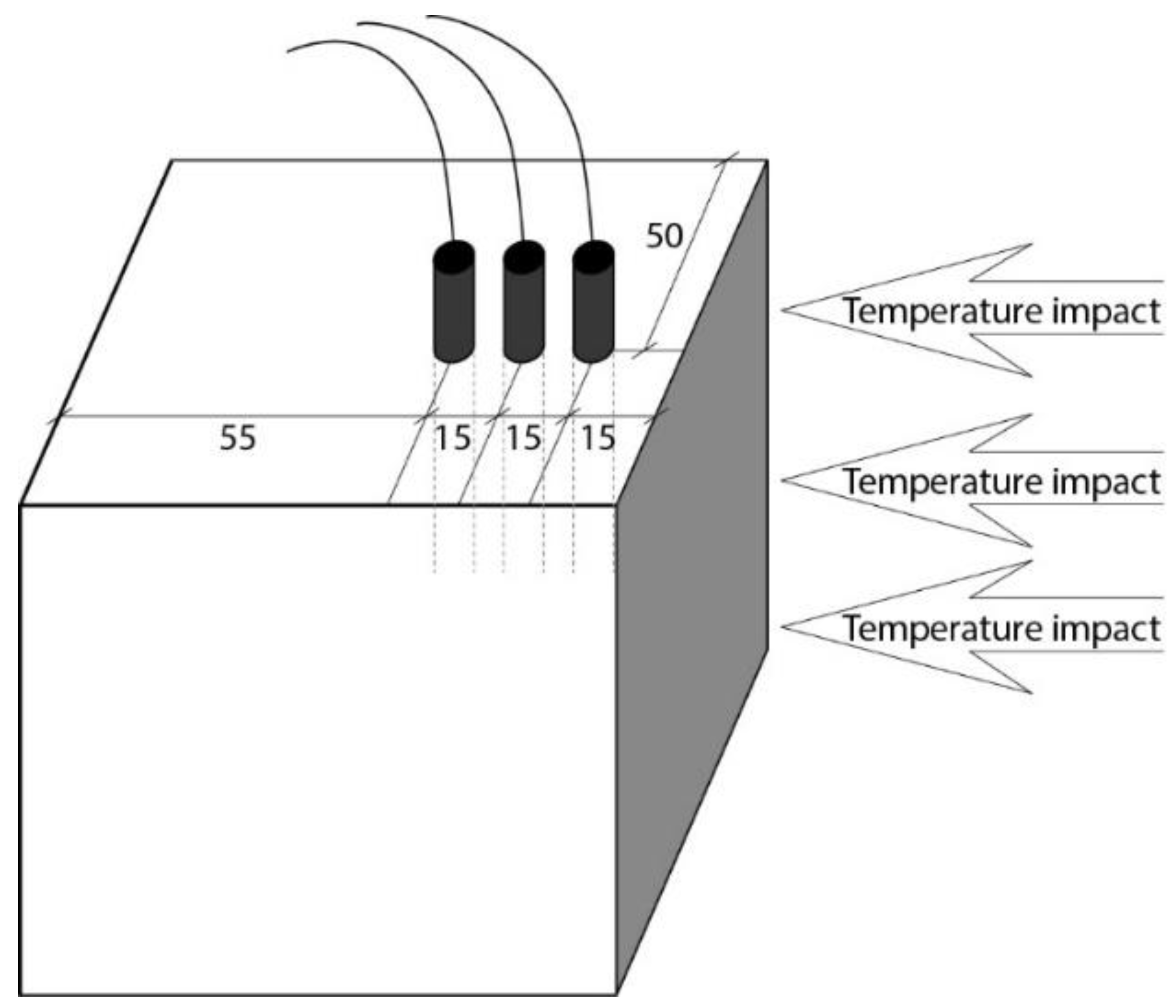
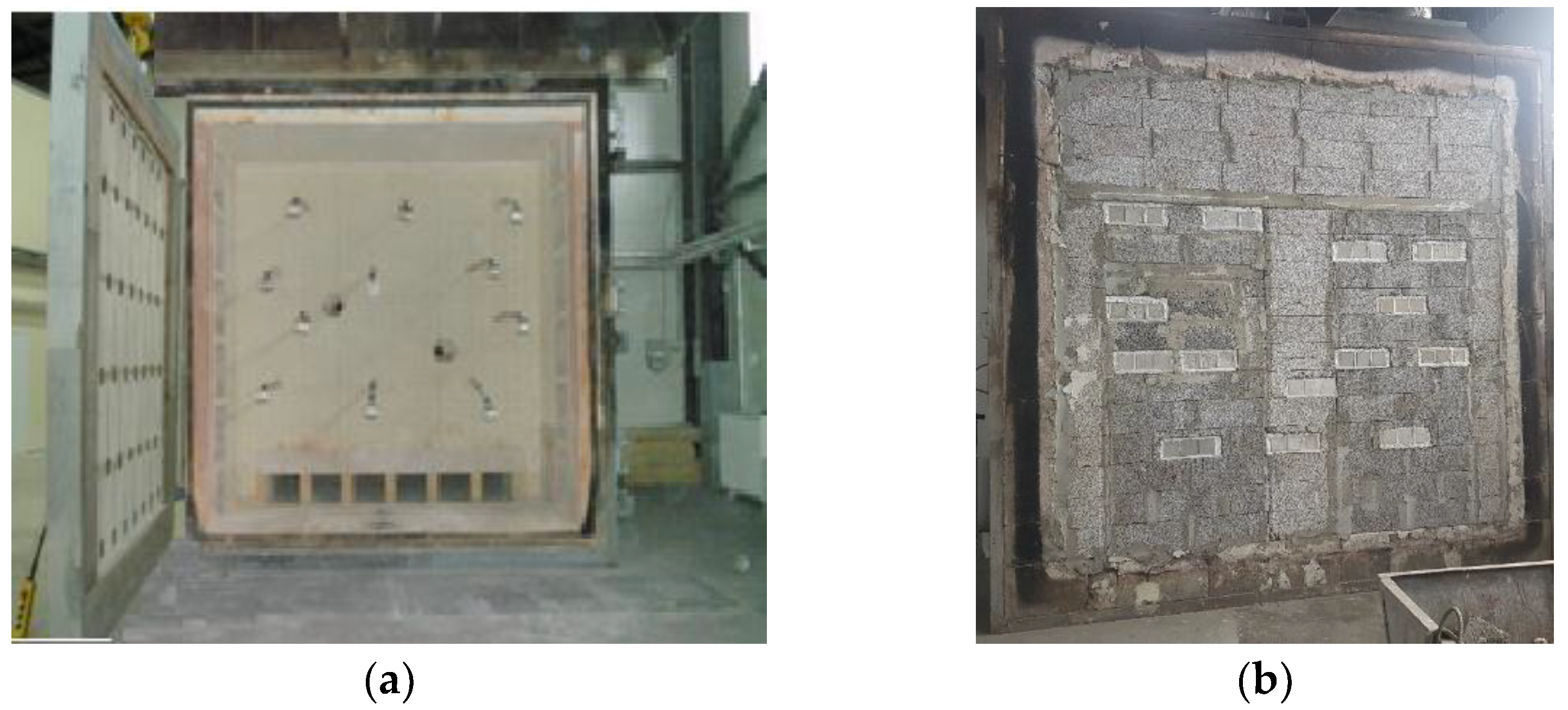

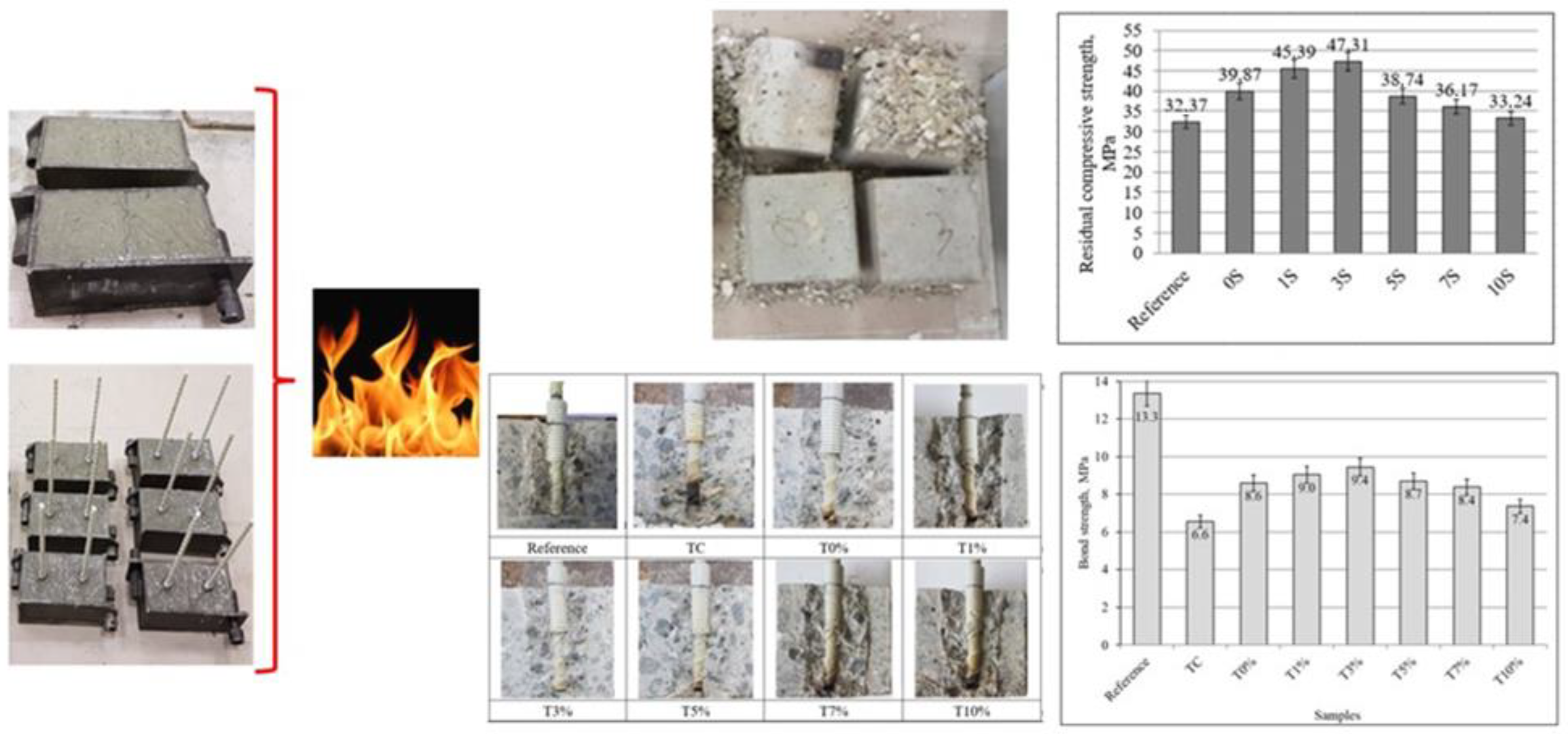
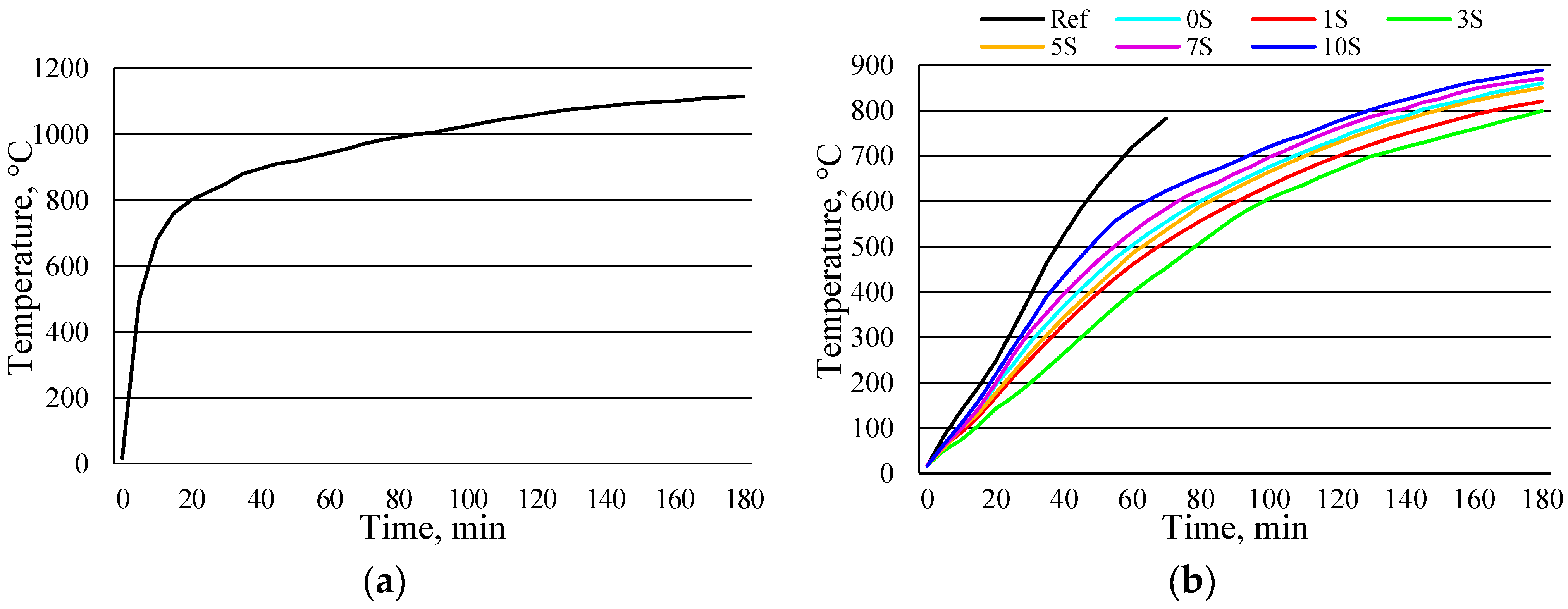
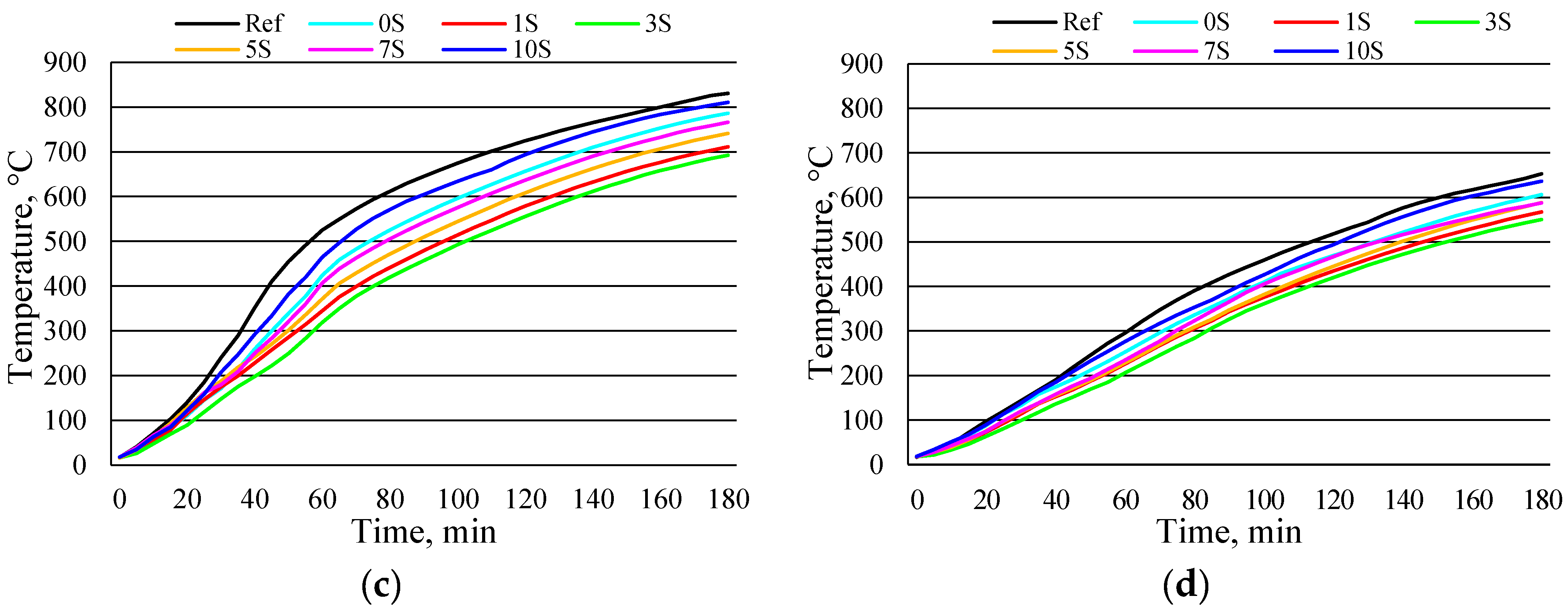
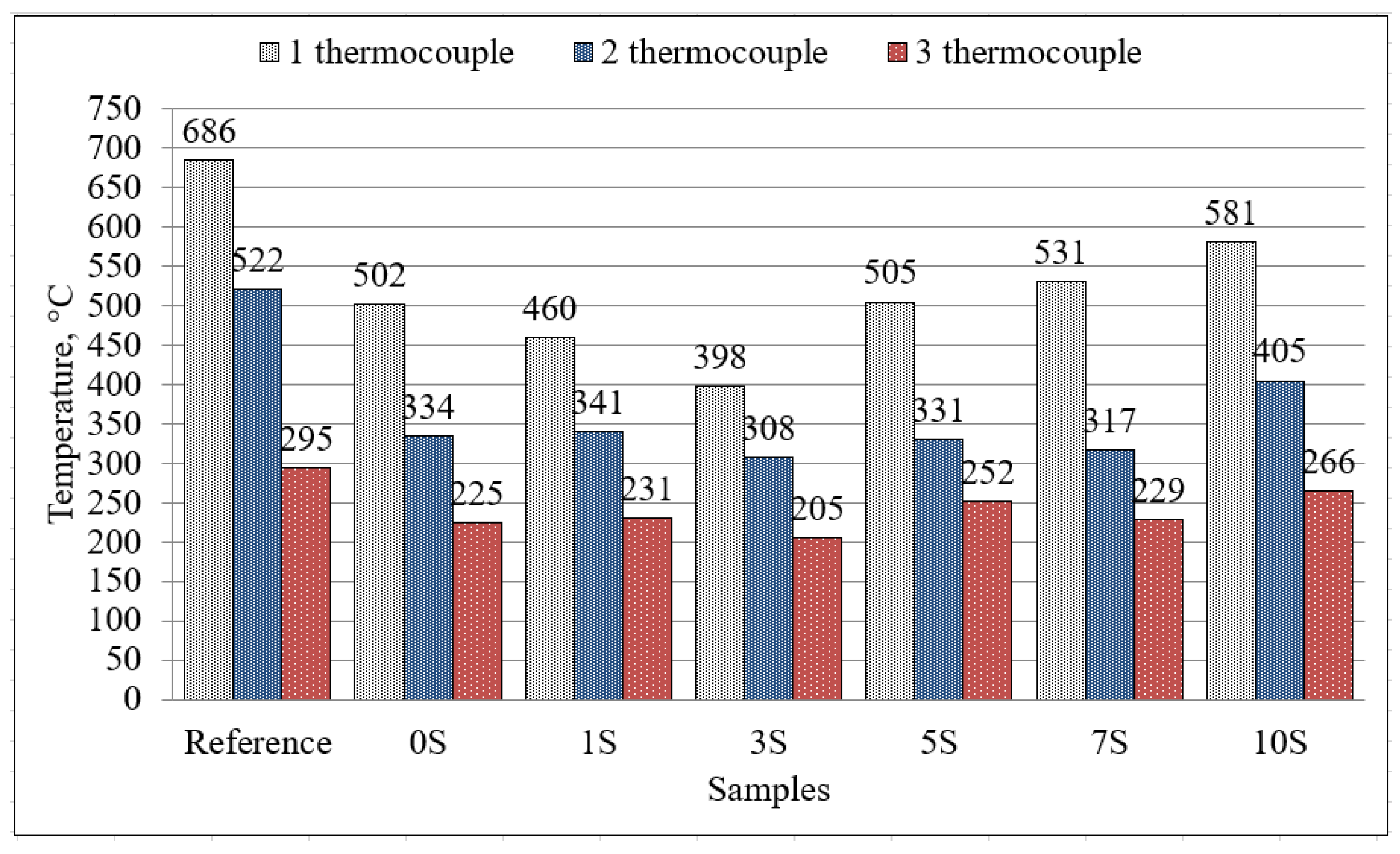
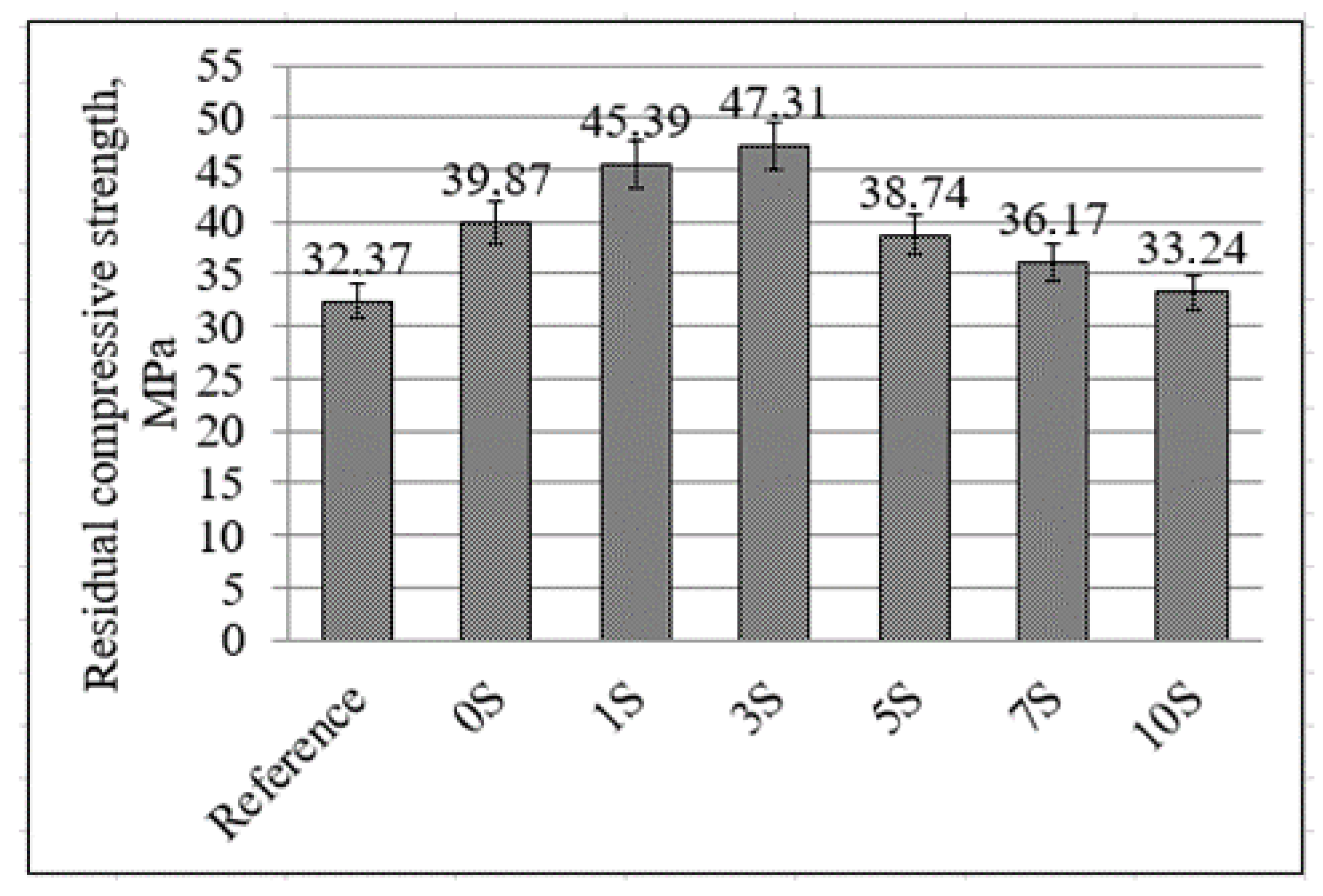
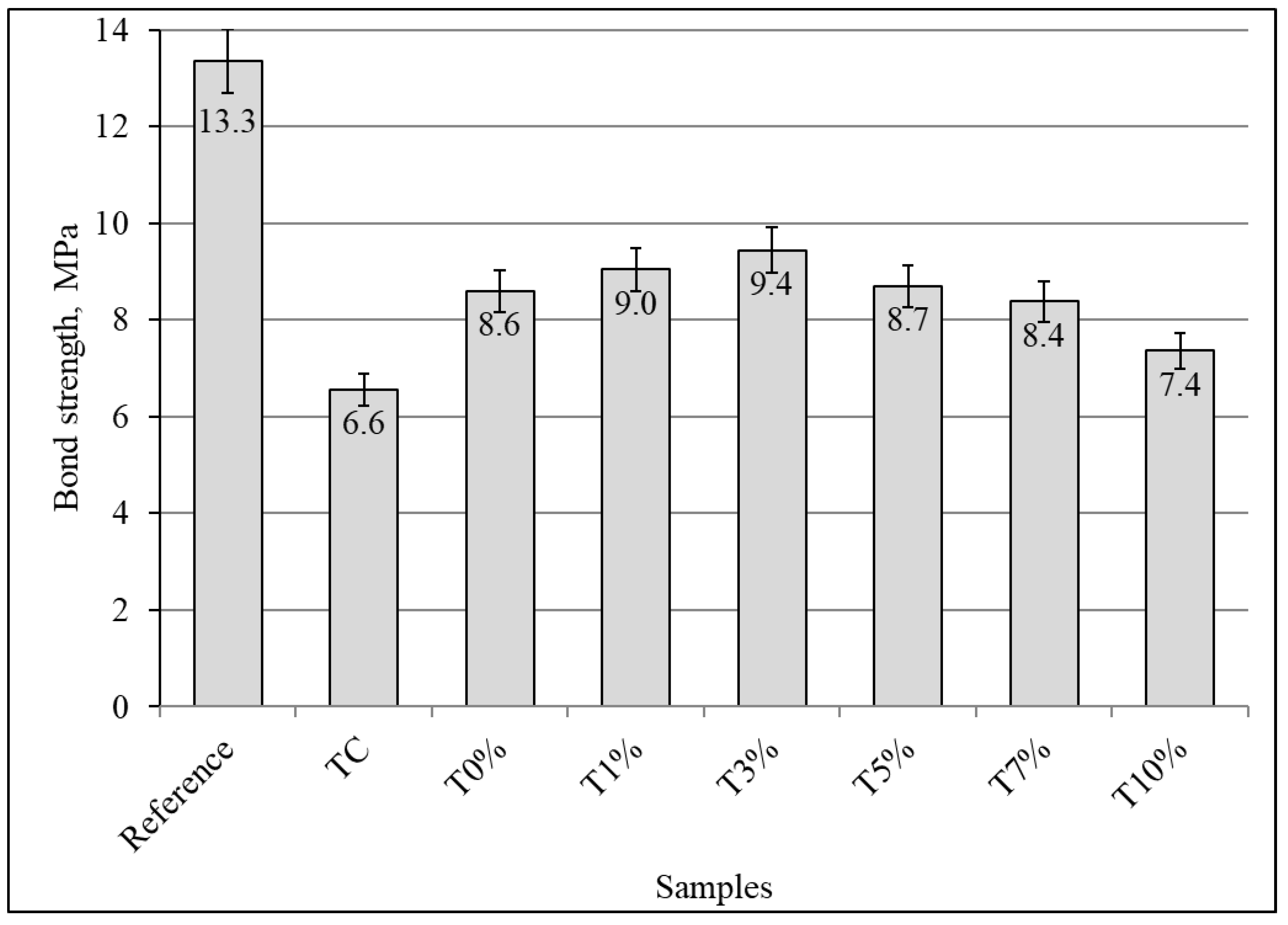
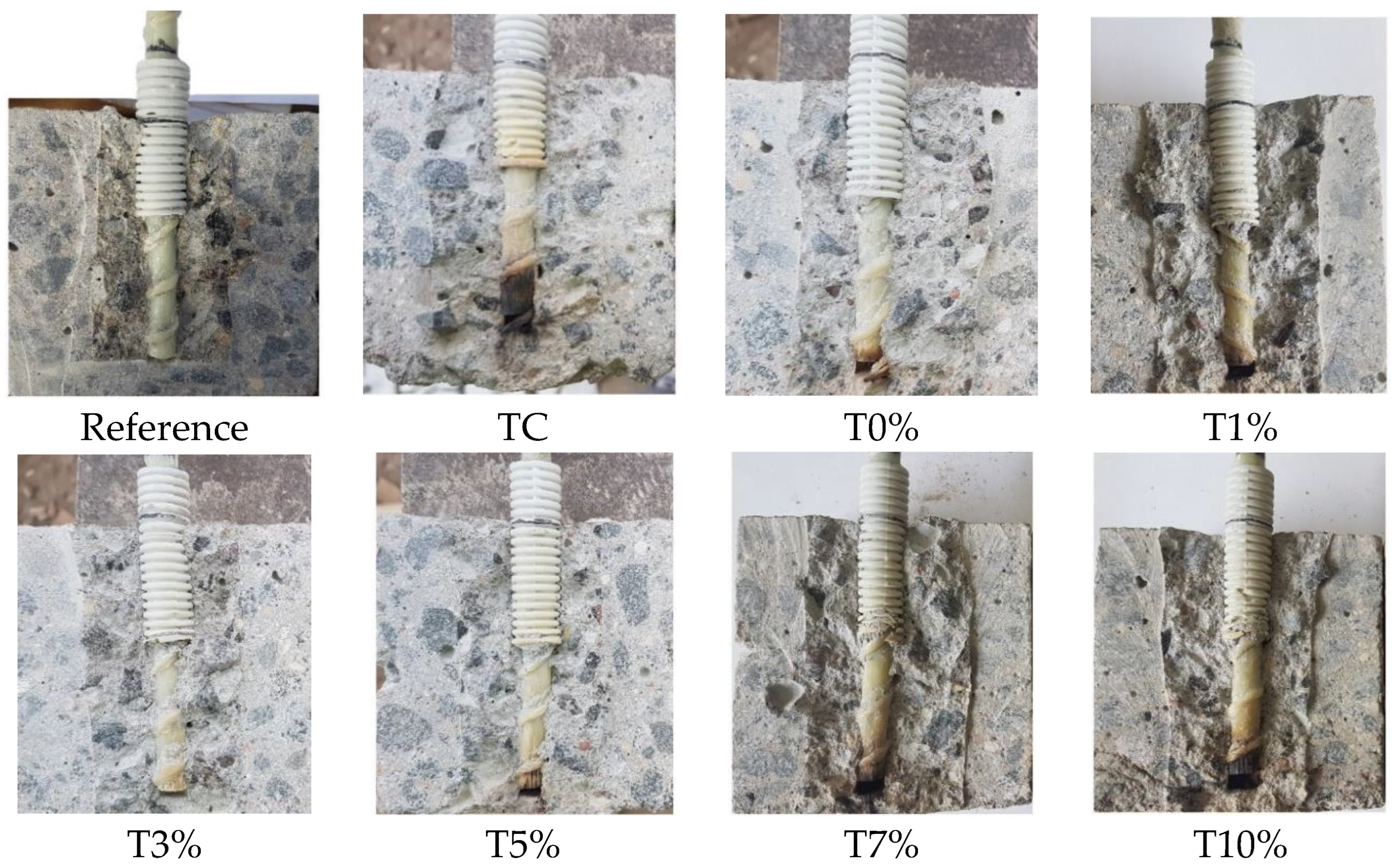
| Materials | Quantities for 1 m3 of Concrete Mixtures |
|---|---|
| Portland cement (C), kg | 305.02 |
| Water (W), L | 130.25 |
| Fine aggregate (0/4 fraction sand), kg | 839.48 |
| Coarse aggregate (5/16 fraction granite macadam), kg | 1068.07 |
| Water and cement ratio, W/C | 0.43 |
| The density of fresh concrete mix, kg/m3 | 2342.82 |
| Coatings | Slag, wt.% | Phosphogypsum, wt.% | Sodium Hydroxide, wt.% | W/S * | Compressive Strength, MPa |
|---|---|---|---|---|---|
| 0S | 100 | 0 | 9.71 | 0.25 | 38.68 |
| 1S | 99 | 1 | 9.71 | 0.25 | 39.53 |
| 3S | 97 | 3 | 9.71 | 0.25 | 39.71 |
| 5S | 95 | 5 | 9.71 | 0.25 | 49.63 |
| 7S | 93 | 7 | 9.71 | 0.25 | 31.12 |
| 10S | 90 | 10 | 9.71 | 0.25 | 28.45 |
Disclaimer/Publisher’s Note: The statements, opinions and data contained in all publications are solely those of the individual author(s) and contributor(s) and not of MDPI and/or the editor(s). MDPI and/or the editor(s) disclaim responsibility for any injury to people or property resulting from any ideas, methods, instructions or products referred to in the content. |
© 2023 by the authors. Licensee MDPI, Basel, Switzerland. This article is an open access article distributed under the terms and conditions of the Creative Commons Attribution (CC BY) license (https://creativecommons.org/licenses/by/4.0/).
Share and Cite
Kielė, A.; Vaičiukynienė, D.; Bertašius, Š.; Krivenko, P.; Bistrickaitė, R.; Jocius, V.; Ramukevičius, D. Alkali-Activated Slag Coatings for Fire Protection of OPC Concrete. Materials 2023, 16, 7477. https://doi.org/10.3390/ma16237477
Kielė A, Vaičiukynienė D, Bertašius Š, Krivenko P, Bistrickaitė R, Jocius V, Ramukevičius D. Alkali-Activated Slag Coatings for Fire Protection of OPC Concrete. Materials. 2023; 16(23):7477. https://doi.org/10.3390/ma16237477
Chicago/Turabian StyleKielė, Andrius, Danutė Vaičiukynienė, Šarūnas Bertašius, Pavel Krivenko, Rėda Bistrickaitė, Vytautas Jocius, and Dainius Ramukevičius. 2023. "Alkali-Activated Slag Coatings for Fire Protection of OPC Concrete" Materials 16, no. 23: 7477. https://doi.org/10.3390/ma16237477
APA StyleKielė, A., Vaičiukynienė, D., Bertašius, Š., Krivenko, P., Bistrickaitė, R., Jocius, V., & Ramukevičius, D. (2023). Alkali-Activated Slag Coatings for Fire Protection of OPC Concrete. Materials, 16(23), 7477. https://doi.org/10.3390/ma16237477








